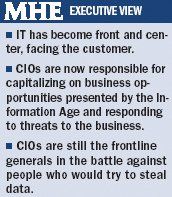CIOs deploy business strategies as technology changes
When it comes to information technology, the more things change, the more work the CIO has to do. Once out of sight and out of mind in the basement mainframe rooms of corporate America, chief information officers are now sitting at the table in corporate boardrooms.
WHEN IT COMES TO INFORMATION technology, the more things change-the more work the CIO has to do. Once out of sight and out of mind in the basement mainframe rooms of corporate America, chief information officers are now sitting at the table in corporate boardrooms.
Both Bruce Goodman, senior vice president and chief service and information officer at Humana, Inc., Louisville, Ky. and Bert Reese, vice president and CIO at Sentara Healthcare, Norfolk, Va., were in the IT field before there were personal computers. In their 30-plus years in the industry, they've each seen the role of the CIO move from a strictly service-oriented one to a strategic one.

The CIO's responsibilities have shifted because information technology has become so pervasive.
"It has become more and more permeated throughout any business over the years, but that's especially true in healthcare," says Goodman who has been in IT for 38 years. "There's hardly anything now that doesn't involve IT."
Goodman says IT not only has come out from behind the scenes, it is now front and center, facing the customer. From retail point-of-sale kiosks to online wellness programs, today's CIOs are responsible for business initiatives that directly impact and are used by customers.
"For example, Humana sends out monthly statements to 4.6 million Medicare members that tell them where they are in the plan and what prescriptions they have-complete with pictures of the pills so they can easily identify them," Goodman says. "A bigger example is how we've worked with our competitors in Florida to set up a multi-payer Web portal. Physicians can get real-time claims status, eligibility information, referrals and more."
At Sentara, Reese is implementing e-medical records across the board.
"We're getting the first hospital ready to go," he says. "That's a tactical thing. From a strategic standpoint, when you have data that can be accessed from home, the hospital, the physician's office-how does that give an advantage to the enterprise, improve patient care, etc.? These are questions the CIO answers."
Reese says healthcare data can be used in two ways. It can report what has been done-how many medications were taken, for instance, or it can influence what will be done.
"Having data available at the bedside, at the point of care, can change the course of what doctors and nurses were going to do," he says. "The data provides the information you need to alter the care for the better."
A SEAT AT THE TABLE
As corporate executives, CIOs are now responsible for capitalizing on business opportunities presented by the Information Age and responding to threats to the business. CIOs develop tactical plans to use information technology to meet business objectives. To do that, they need to understand business as well as they understand technology.
"The CIO has to learn the key levers in their business that drive growth and profits," Goodman says. "We have to know where technology is going so we can suggest where to start early pilots in order to position the company to exploit new technologies for a competitive advantage."
In the Scope of Virtual Health and the Future of “Website” Manner, Per Ateev Mehrotra
August 10th 2023Briana Contreras, an editor of Managed Healthcare Executive, had the pleasure of catching up with MHE Editorial Advisory Board Member, Ateev Mehrotra, MD, MPH, who is a professor of healthcare policy at Harvard Medical School and an Associate Professor of Medicine and Hospitalist at Beth Israel Deaconess Medical Center.
Listen